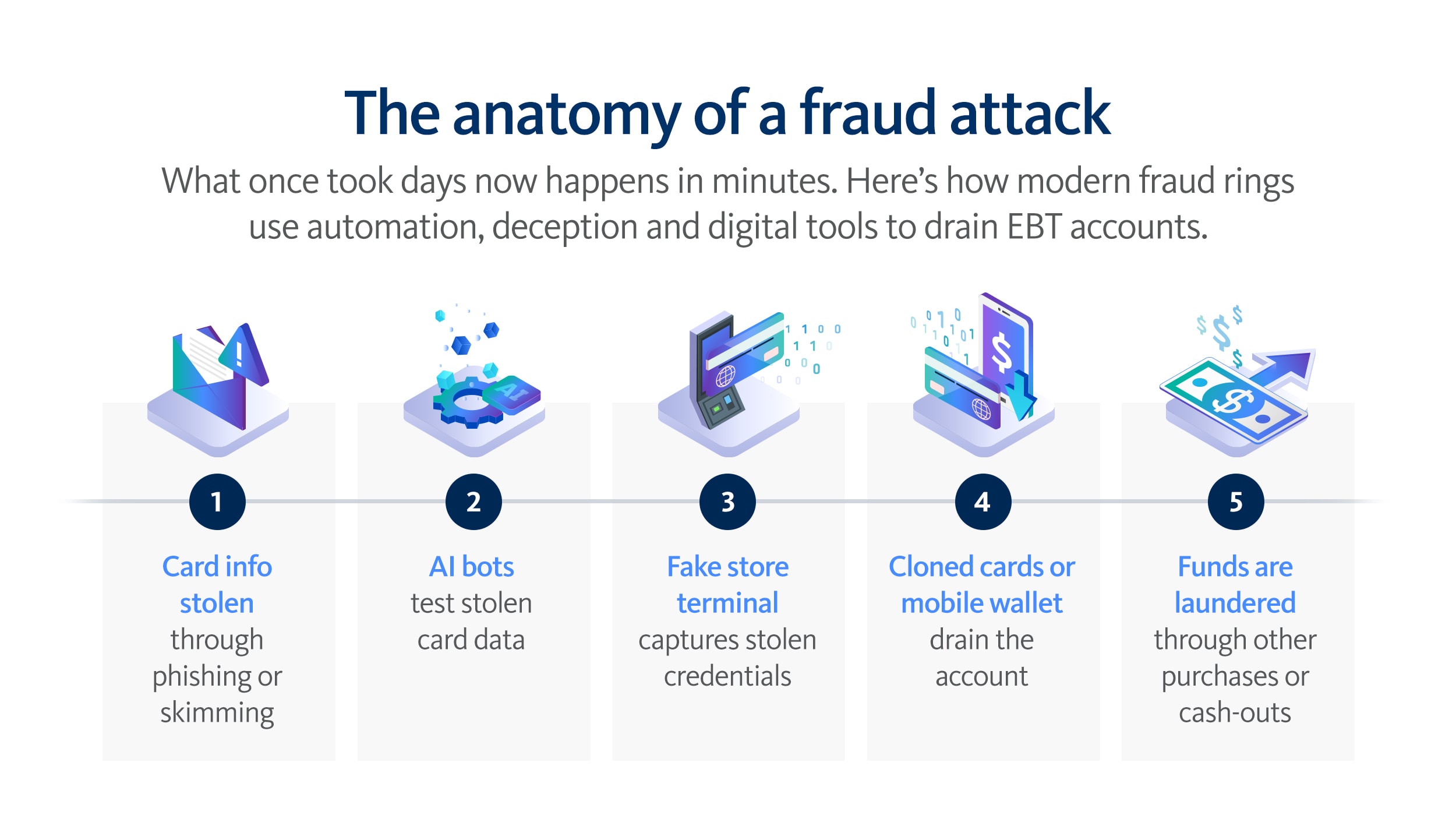Defending against America’s EBT fraud crisis
AI and outdated tech are fueling a new wave of benefit theft
What once required brute force or insider access can now be accomplished in seconds with off-the-shelf AI tools and stolen data. The scale and sophistication of today’s fraud tactics are unlike anything we've seen in the history of government-administered benefit programs. As the threat landscape evolves, so must our defenses.
AI and automation are accelerating fraud tactics
Fraudsters are embracing automation at alarming speeds. Using AI-driven bots, bad actors can now run thousands of credential tests, launch scripted voice attacks, web-based attacks, and even synthesize new identities to exploit vulnerabilities in state systems. These are not isolated incidents, but coordinated efforts designed to drain millions of dollars from benefit programs meant for families in need.
Outdated card tech leaves EBT systems exposed
A major vulnerability in EBT systems is the continued reliance on magnetic stripe technology. Unlike chip-enabled banking cards, magstripe cards can be easily cloned once skimmed. This means a single compromised point-of-sale terminal can trigger widespread fraud. The absence of EMV chips and three-digit security codes further opens the door to online theft, where no extra verification is required. Once benefits are loaded, cloned cards can rapidly drain funds, often before households even realize anything is wrong.
Related: Preventing fraud in EBT payments

Fake payment terminals are becoming more common
A growing threat comes from fake payment terminals. Criminals are setting up these terminals using stolen or even valid store ID numbers, paired with fake business names. The companies that help set up these payment systems often don’t have access to the USDA’s official store database, so they can’t confirm whether the store is real. Without that check, fake terminals can slip through and operate undetected, sometimes in several states at once.
Social engineering exploits human vulnerabilities
We're also seeing a sharp rise in social engineering. Advanced phishing and smishing campaigns are now targeting not just cardholders but retail employees and state agency staff. By impersonating trusted sources or manufacturing a sense of urgency, these scams lead individuals to inadvertently hand over access credentials, which are then used to launch deeper attacks, from setting up terminals to manipulating benefit data.
Related: Two states leading the way in SNAP EBT modernization, fraud prevention
Digital wallets introduce new risks
Adding to the challenge is the growing role of digital wallets and mobile payment apps. While these technologies promise convenience, they can also introduce weak points where fraudsters intercept or reroute transactions, especially when integrated with platforms that haven’t been hardened against abuse.
EBT fraud: at-a-glance
- $300,000 can be stolen per skimming device
- $35B lost to synthetic identity fraud in 2023
- 51% of AI tools targeted for credential theft
- 68% of data breaches linked to human error and social engineering
- 315,000+ households had SNAP benefits replaced since 2023
- 90% of businesses expect a rise in digital payment fraud
- 98% of cyberattacks involve some form of social engineering
Sources:
NYPost
Boston Fed
FNS
GlobeNewsWire
With federal reimbursements gone, states face mounting pressure
And while temporary federal reimbursements helped victims of skimming and cloning for a time, funding expired at the end of 2024. States are now left to shoulder the full burden, both in terms of financial loss and public trust. With no backstop and increasing public scrutiny, the demand for proactive, affordable fraud prevention has never been greater.
At Conduent, our experts work closely with state and federal agencies to stay ahead of evolving fraud threats, especially those tied to outdated technology and internet-based scams. Many EBT cards still rely on magstripes, which lack the added protection of EMV chips and 3-digit security codes. That makes them more vulnerable to both in-person and online fraud.
To help states act quickly and precisely, we've developed two key solutions:
- Terminal-level blocking lets states disable only the specific payment terminals being used for fraud. This avoids disrupting legitimate retailers while aligning with USDA guidance for targeted, policy-compliant fraud prevention.
- FNS out-of-state blocking, now being piloted, adds another layer of defense. It gives states the ability to block out-of-state transactions — both in-store and online— based on known fraud patterns. This helps stop repeat offenders who operate across state lines.
Related: The hidden risks in government payments likely to affect recipients and taxpayers
Protecting EBT programs requires modern tools and shared insight
The road ahead requires coordinated action: updating card technologies, improving real-time fraud analytics, closing verification gaps and empowering states with better tools. I’ve seen firsthand how rapidly these threats evolve, but I’ve also seen what’s possible when states are equipped with the right support and insight.
Let’s talk about how we can protect your program, together.
Conduent stands ready to help. Our experts understand the operational realities of EBT programs and are actively partnering with agencies to build resilience against fraud. Learn more now.